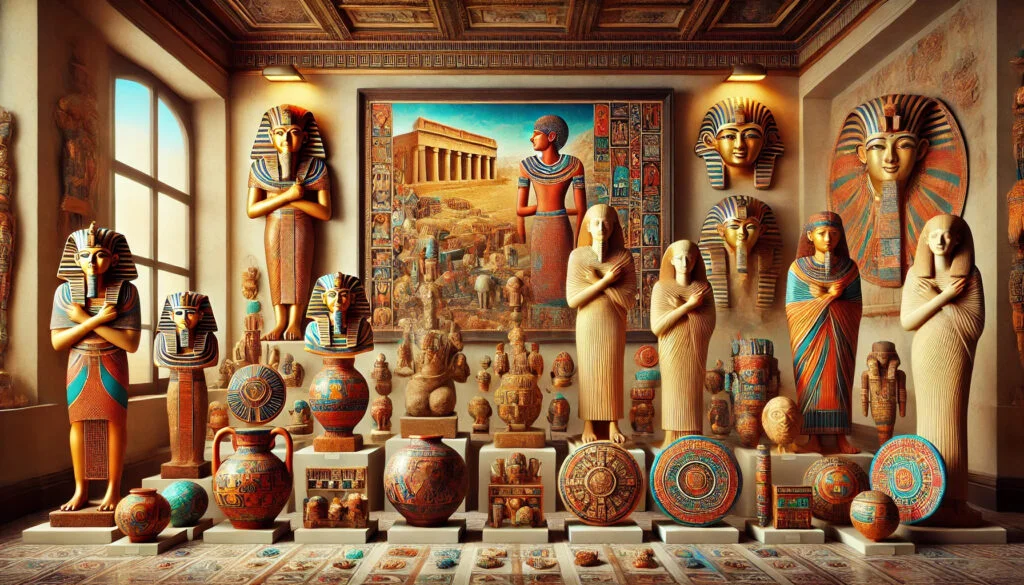Ancient art tells a story of humanity, capturing the creativity, beliefs, and values of early civilizations. From the mysterious hieroglyphics of Egypt to the lifelike sculptures of Greece, ancient art provides a window into the past, offering insight into the thoughts and emotions of our ancestors. Ancient civilizations viewed art as a medium to express spirituality, honor leaders, or convey daily life, leaving behind works that have intrigued historians, artists, and enthusiasts alike for centuries.
What is Ancient Art?
Ancient art, broadly speaking, refers to creative works produced in prehistoric and early historic societies before the fall of the Western Roman Empire. Its defining characteristics vary greatly between cultures but often include symbolism, spirituality, and a strong connection to nature. Unlike modern art, which often values individualism, ancient art was deeply communal, used to represent the values, beliefs, and achievements of entire civilizations. The remains of pottery, statues, and painted scenes illustrate how early societies celebrated their deities, documented history, and commemorated the deceased.
Key Characteristics of Ancient Art
One of the most distinct features of ancient art is its rich use of symbolism. Symbols often represented complex ideas, allowing artists to convey messages beyond literal interpretation. Nature, mythological beings, and abstract shapes were recurrent elements, each carrying deep meanings. Ancient Egyptian art, for instance, used symbolic representation to honor gods and guide souls through the afterlife, while Greek art celebrated the human form, emphasizing proportion and harmony.
Techniques and Materials in Ancient Art
Ancient artists employed an impressive range of techniques, from intricate carving to the earliest forms of painting and pottery. Depending on available resources, artists in different regions developed unique methods to bring their visions to life. Egyptians utilized stone and gold in their temples and tombs, while Greeks refined techniques in sculpture, creating lifelike statues of gods, athletes, and rulers. Mesopotamians, on the other hand, are known for their relief carvings and cuneiform tablets that combine both art and language. Each civilization’s unique materials and methods give us a glimpse into their values and environmental conditions.
The Role of Religion in Ancient Art
For many ancient civilizations, art was not just decorative but sacred, often acting as a medium for worship and spiritual expression. In Egypt, art was intricately linked with religion, with many works depicting gods, goddesses, and scenes from the afterlife. The grandeur of Egyptian temples and tomb paintings exemplified a belief in the divine and the eternal, creating masterpieces meant to guide souls into the next world. Similarly, in Mesopotamia, ziggurats and religious sculptures paid homage to the gods, showing art’s power in bridging the earthly with the divine.
Ancient Art as Historical Record
Ancient art also serves as an invaluable historical record. Every statue, painting, or architectural design offers insights into the daily lives, social structures, and beliefs of the people who created them. For example, frescoes in ancient Roman villas depict scenes of daily life, from banquets to market scenes, offering a rare look into the social fabric of Roman society. By studying these artistic records, historians can reconstruct aspects of ancient life, filling in the gaps left by written texts alone.
Ancient Egyptian Art
Egyptian art is one of the most celebrated forms of ancient artistic expression, recognizable for its distinct use of color, symbolism, and adherence to form. The Egyptians believed in an afterlife, creating elaborate tombs and art to ensure safe passage for the deceased. They adorned their walls with hieroglyphics, which served both as art and written language, chronicling their beliefs, histories, and stories of the gods. Much of Egyptian art was functional, crafted to accompany the deceased in the afterlife, including golden statues, intricate sarcophagi, and vibrant wall paintings.
Hieroglyphics and Symbolism
Hieroglyphics stand as one of the earliest forms of written language and served as an important medium for storytelling and recording history. Each symbol or “glyph” held specific meanings and was used to create both decorative and functional art. This symbolic language allowed Egyptians to tell complex stories, honoring the gods and reflecting on human mortality.
Funerary Art in Egypt
Funerary art in Egypt is perhaps the most iconic, embodying the Egyptian belief in life after death. Pharaohs were entombed with artifacts, jewelry, and food for their journey to the afterlife. Many tombs, like that of Tutankhamun, housed lavish treasures meant to ensure a successful transition. Sarcophagi were decorated with images of deities and spells from the “Book of the Dead,” crafted with precision and care to honor the departed.
Mesopotamian Art
Mesopotamian art captures the essence of one of the world’s earliest civilizations. Located between the Tigris and Euphrates rivers, Mesopotamia is often regarded as the “cradle of civilization.” Here, art flourished as a way to document society’s values, religious beliefs, and royal accomplishments. Statues and relief carvings depict kings, deities, and mythological creatures, often crafted with the intent to glorify the gods and rulers of the land.
The Ziggurat and Mesopotamian Architecture
Ziggurats are one of Mesopotamia’s architectural marvels, with towering structures built as temples to the gods. These stepped pyramids were not only feats of engineering but also visual representations of the sacred, reaching toward the heavens. Ziggurats symbolized the bridge between earth and sky, creating a place for the gods to dwell among humans.
Ancient Greek Art
Greek art stands as one of the pinnacles of ancient creativity, marked by its idealized representation of the human form and its influence on Western aesthetics. Greek artists pioneered the exploration of form, symmetry, and proportion, producing sculptures, vases, and architecture that celebrated human achievement. Through statues of gods and athletes, Greek art celebrated both physical and intellectual pursuits, embodying ideals of beauty and harmony that continue to inspire modern art.
Classical Greek Sculpture
Classical Greek sculpture exemplifies the ideal human form, depicting men and women in balanced, realistic poses. Known for their lifelike quality and intricate details, these sculptures were not only decorative but also philosophical, as the Greeks believed the human body was a reflection of the soul. Artists like Phidias and Praxiteles revolutionized sculpture, creating works that conveyed emotion, movement, and lifelike presence.
Vase Painting in Ancient Greece
Greek vase painting was an art form that combined functionality with storytelling. Black-figure and red-figure techniques brought to life scenes from mythology, sports, and daily life, giving us insight into Greek culture. These vases depicted heroes, gods, and intricate patterns that celebrated their mythology and the human experience.
Roman Art and Its Legacy
Roman art, drawing heavily from Greek traditions, became an influential force in shaping Western art. Romans expanded on Greek techniques but infused their work with practicality and an emphasis on portraiture. Frescoes, mosaics, and statues decorated Roman homes, public buildings, and temples, capturing both mythological scenes and real-life events. The legacy of Roman art can be seen in Renaissance paintings and even in modern architectural designs.



